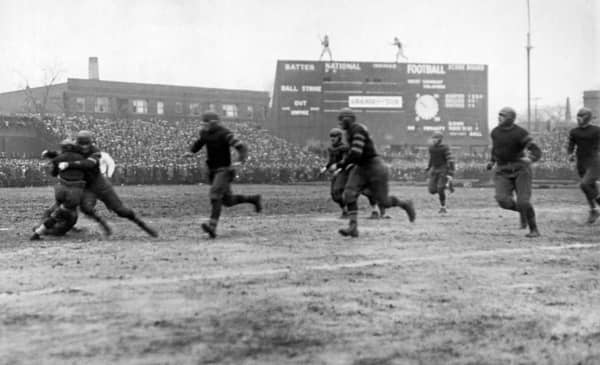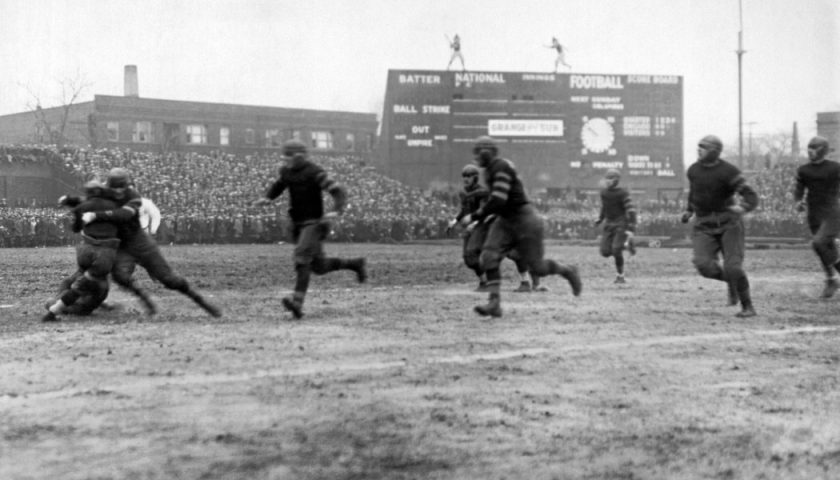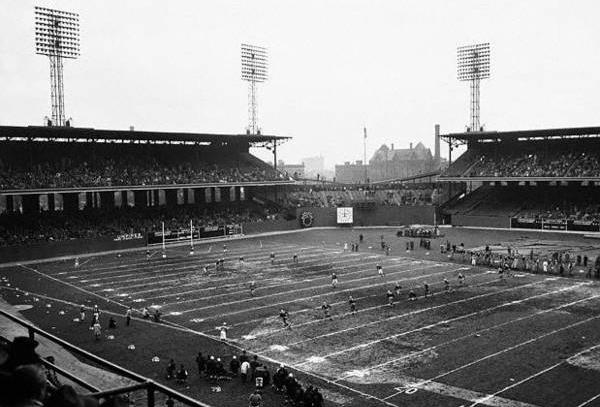

The Chicago Cardinals Vs The Chicago Bears In 1925
“Back to school?” More like “Back to Football,” and it’s time we pay respects to teams, and the league itself, in how they’ve gotten up to this point. In other words, Sports Al Dente is proud to bring you our exclusive classroom series: The Perfect Recipe That Made The NFL. Paint the town [Cardinal] red as we ascend afloat with one of the oldest clubs respectfully known as the Arizona Cardinals.
Not in Arizona, but its seeds originally blossomed in Chicago back in 1898. Team owner Chris O’Brien, in his decision to relocate the team at Normal Field, right by Normal Boulevard and Racine Avenue in southern Chicago, have briefly adopted the team name “The Normals.”
The team name “Cardinals” derived from O’Brien’s pick up of jerseys from the University of Chicago, all of which sported a light, faded maroon color. In response to the curiosity and criticism of the uniforms, O’Brien answered back with “it’s Cardinal red,” thus the name was born. Of course, the team name “Chicago Normals” wasn’t as common a name that many remembered, however, the team compromised using “Cardinals,” alas, have become known as the “Racine Cardinals.” After playing in some championship football leagues in 1917, the American Professional Football Association (APFA) welcomed the Cardinals in (a franchise fee only costing $100 during that time). In 1920, two years prior to the APFA becoming the National Football League (NFL), the team renamed into the “Chicago [Racine] Cardinals.”
Their team record after its first season in the NFL? The Cardinals wrapped up with a 6-2-1 record, respectively. Immediately, a new team began brewing in Racine, Wisconsin, a city mistakingly construed as where the Cardinals football team was born, causing the Cardinal club to lose loyal support from fans (the first display of bandwagon fans?). That same year was also the time the Cardinals moved away from Normal Field to play at Comiskey Park in the late 1920s, playing there until 1959. Those fans realizing the Cardinal club derived from Chicago, and not Wisconsin, likely caused the loss of support as team identity is huge among the pro football community.
Keeping steady as the seasons progressed approaching the 1930s, finances became an issue for the Cardinals in staying above water. Despite that, the Cardinals won their first official championship in 1925, with an 11-2-1 record, but the league never presented the trophy due to an incident involving one of their opponents being in hot water for infringing field rights against another club (something known as “territorial rights”). NFL commissioner Joe Carr stepped in and revoked the charters and their season schedule of that very club for the infringement–that club being known as the “Pottsville Maroons,” who had a game scheduled on the same field on the same day as the other football club, named the “Frankford Yellow Jackets,” had. (Unlikely that this will happen today, but you can see how tough of a job employees have creating season schedules)
That business league drama was what led the league to never giving that championship to the Cardinals, unable to confront the situation prior to their match-up against the Maroons which, in turn, would affect their season record.
Lack of steady finances ran amok with O’Brien, forcing him to give away his star players and the team itself. He received $25,000 from a medical practitioner by the name of David Jones, and he took over as the team owner.
Acquiring solid star players, the team still wasn’t enough to entice fans, old and new, or enough to generate profits during the season in the early 1930s. By that time, Jones was running dry as well, forcing him to sell off the team, not even managing it for a decade.
Sold at double the price he bought it for, Jones hands off the duties of team ownership to a big-time [Chicago] Bears fan named Charles W. Bidwill Sr. To this day, the Bidwill family maintain team ownership of the Cardinals.
The 1930s was a decade many Cardinal fans would love to forget, having only two winning seasons (1931 and 1935), and one season finishing with a 1-10 record in 1939. As World War II was declared, a shortage of players resulted in the Cardinals ‘teaming’ up with the Pittsburgh Steelers (yes, seriously) temporarily calling their club the “Card-Pitts” or oddly enough, the “Carpets.” Such a thing would never happen today (or will it?), as both teams shared in splitting home games on each other’s turf. The only closely recorded game was against the Cleveland Rams (now the Los Angeles Rams), losing 30-28. After that, it wasn’t a pretty season for the “Carpets” getting slaughtered, pound for pound by blowouts.

A look at the “Carpets”
Two years after World War II officially ended, the Cardinals signed Charly Trippi before the beloved Charles Bidwill Sr. passed away at the age of 51. Trippi’s 75-yard punt return and a 44-yard rush brought the Cardinals’ an NFL championship, beating the Philadelphia Eagles, 28-21.
Entering into the 1950s, where radio and television were technological advancements adopted into the average American homes, the Cardinals held up financially only to see that ticket sales were poor and not many cared to watch the “faded maroon” squad, primarily due to the high recognition and growing success of the Chicago Bears. Holding memorable moments and games in Comiskey Park that were going unnoticed, the Bidwill family and the NFL struck an agreement in relocating the team to St. Louis, Missouri in time for the 1960s decade.
The Cardinals’ only competition was the city’s baseball club, which, to this day is still called, the St. Louis Cardinals. Avoiding confusion, fans referred to the Cardinals in baseball as, well, “the baseball Cardinals.” (Imagine big market cities like New York having the same team name in every major sport.)
Similar to life’s ups and downs, the Cardinals found a balance better than football life in Chicago. Still not as impressive, the Cardinals sought a record improvement winning at least eight games but missed the playoffs three times. During the early 1960s, both Charles Jr. and Bill, sons of the late Charles Sr., wanted to relocate the team to Atlanta as they were building a new stadium. Not wanting to disappoint the fans in St. Louis, they went on to build a new ‘house’ themselves, as the new stadium in Atlanta gave birth to a new franchise: the Atlanta Falcons (1966). It wasn’t until the transformation of the league that the St. Louis Cardinals, ‘the football Cardinals,’ were assigned to the National Football Conference (NFC) listing with clubs like the Dallas Cowboys and the New York Giants.
Now going in full color (television sets) into the 1970s, one of the newest technological breakthroughs, the Cardinals weren’t flying rainbows. Tight end (TE) J.V. Cain passed away of a heart failure during summer training camp. At the bottom of the downward spiral, included first-round draft pick (1978) Steve Little who was fully paralyzed in a car accident in 1980. It was one heartache after another for the Cardinals.
To mend the pain means to relocate? Bill Bidwill wanted to, and it was a choice between Jacksonville, Baltimore, and Phoenix. Bill chose Phoenix and because of upset fans, it was once mentioned that he did not attend home games for his own personal safety. The last game the Cardinals played in St. Louis was on December 13, 1987, defeating the New York Giants, 27-24.
Playing at the Sun Stadium at Arizona State University (ASU) while loans were still being handled in building a fresh, new stadium in Phoenix, the Cardinals were rightfully called the “Phoenix Cardinals.” However, fans wanted the team to be called the “Arizona Cardinals” to which Bill Bidwill catered to. League approved the new name in 1994.
Four years later, 1998, ASU and a hometown favorite named Jake “the Snake” Plummer painted up the rusted colors for the Cardinals. Arizona finished the season with a record 9-7. He helped bring the Cardinals to their first playoff appearance since 1982.
While finalizing the loans in building a new stadium in the early 2000s, another heartache came to the ailing Cardinals. ASU’s own, and Cardinals’ safety, Pat Tillman, passed away in April 2004 after enlisting in the military in response to the 9/11 tragedy; He declined a contract worth $3 million. US troops, and NFL analysts, have paid tribute to Tillman’s service and work featured on a segment from the morning show NFL on FOX – FOX NFL Sunday in Afghanistan in 2009 (available on DVD, by the way).
Along the way during the millennia, the Cardinals brought in quarterback (QB) Kurt Warner (Northern Iowa) and Steelers’ offensive coordinator Ken Whisenhunt (Georgia Tech).
Any improvements? You bet! The year 2009 saw the Cardinals making a run at their first NFC championship, downing the Eagles, 32-25, and onto their first Super Bowl championship appearance since the team played in Chicago. Their opponent, frankly enough, was the team they linked arms with during the historic boom of World War II: the Pittsburgh Steelers. Close but no cigar, as the Arizona Cardinals feathered out against the Steelers, 27-23.
In 2010, Kurt Warner, despite his promises of playing out his contract, hung up his jersey to retire as a Cardinal. Undergoing yet another slew of dry seasons, and having a bit of a “quarterback crisis,” the Cardinals struggled to solidify a run in the playoffs. The last playoff appearance since the time of this post was the 2015-2016 season, when Arizona lost to the Carolina Panthers, 49-15 (surely Cardinals fans were sickened from the excessive ‘dabbing’ by Panthers and Panthers fans).
Financial struggles, poor signings and trades, low ticket sales due to the overshadowing of the [Chicago] Bears, team name changes, relocations and the hotly debated “curse” in not earning a championship since 1947, the Cardinals still stand strong. One thing that hasn’t changed much, or at all, is their team colors. While it may be “faded maroon,” their fan base, including the strong, loyal ones from Chicago, haven’t, and that passion will never fade.
